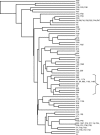Use of a variable amplicon typing scheme reveals considerable variation in the accessory genomes of isolates of Burkholderia pseudomallei
- PMID: 16597858
- PMCID: PMC1448637
- DOI: 10.1128/JCM.44.4.1323-1334.2006
Use of a variable amplicon typing scheme reveals considerable variation in the accessory genomes of isolates of Burkholderia pseudomallei
Abstract
Melioidosis, a disease caused by the bacterium Burkholderia pseudomallei, is endemic in southeast Asia and northern Australia. We used suppression subtractive hybridization (SSH) to identify sequences that varied between two B. pseudomallei isolates from Australia and determined the distribution of 45 SSH-derived sequences among a panel of B. pseudomallei and B. thailandensis isolates. Sequences exhibiting variable prevalence were included in a variable amplicon typing (VAT) scheme designed to score the presence or absence of 14 PCR amplicons. VAT analysis was carried out with 48 isolates from Thailand, which were typed by multilocus sequence typing (MLST), and 44 isolates from Australia of known MLST type. The VAT scheme could be used to divide the 48 isolates from Thailand into 23 VAT types and the 44 isolates from Australia into 36 VAT types. Some of the sequences included in the VAT scheme were more commonly PCR positive among isolates from Australia than among isolates from Thailand, and vice versa. No isolate from Australia was PCR positive for genomic island 11 or a putative transposase sequence, whereas four SSH-derived sequences were far more prevalent among the Australian isolates. Analysis based on the VAT scheme indicated that the isolates clustered into groups, some of which were mainly or exclusively from one geographical origin. One cluster included Australian isolates that were mostly associated with severe disease, including rare neurological melioidosis, suggesting that the content of the accessory genome may play an important role in determining the clinical manifestation of the disease.
Figures



Similar articles
-
Burkholderia pseudomallei animal and human isolates from Malaysia exhibit different phenotypic characteristics.Diagn Microbiol Infect Dis. 2007 Jul;58(3):263-70. doi: 10.1016/j.diagmicrobio.2007.01.002. Epub 2007 Mar 9. Diagn Microbiol Infect Dis. 2007. PMID: 17350202
-
Molecular analysis of clinical Burkholderia pseudomallei isolates from southwestern coastal region of India, using multi-locus sequence typing.PLoS Negl Trop Dis. 2018 Nov 12;12(11):e0006915. doi: 10.1371/journal.pntd.0006915. eCollection 2018 Nov. PLoS Negl Trop Dis. 2018. PMID: 30418974 Free PMC article.
-
Genomic fingerprinting of Burkholderia pseudomallei and B. mallei pathogens with DNA array based on interspecies sequence differences obtained by subtractive hybridization.Res Microbiol. 2006 Sep;157(7):684-92. doi: 10.1016/j.resmic.2006.02.008. Epub 2006 Mar 27. Res Microbiol. 2006. PMID: 16621455
-
Burkholderia pseudomallei: Challenges for the Clinical Microbiology Laboratory.J Clin Microbiol. 2016 Dec;54(12):2866-2873. doi: 10.1128/JCM.01636-16. Epub 2016 Sep 21. J Clin Microbiol. 2016. PMID: 27654336 Free PMC article. Review.
-
Advances and remaining uncertainties in the epidemiology of Burkholderia pseudomallei and melioidosis.Trans R Soc Trop Med Hyg. 2008 Mar;102(3):225-7. doi: 10.1016/j.trstmh.2007.11.005. Epub 2007 Dec 31. Trans R Soc Trop Med Hyg. 2008. PMID: 18166205 Review.
Cited by
-
Burkholderia pseudomallei genome plasticity associated with genomic island variation.BMC Genomics. 2008 Apr 25;9:190. doi: 10.1186/1471-2164-9-190. BMC Genomics. 2008. PMID: 18439288 Free PMC article.
-
Human Melioidosis.Clin Microbiol Rev. 2020 Mar 11;33(2):e00006-19. doi: 10.1128/CMR.00006-19. Print 2020 Mar 18. Clin Microbiol Rev. 2020. PMID: 32161067 Free PMC article. Review.
-
The core and accessory genomes of Burkholderia pseudomallei: implications for human melioidosis.PLoS Pathog. 2008 Oct;4(10):e1000178. doi: 10.1371/journal.ppat.1000178. Epub 2008 Oct 17. PLoS Pathog. 2008. PMID: 18927621 Free PMC article.
-
Genomic islands from five strains of Burkholderia pseudomallei.BMC Genomics. 2008 Nov 27;9:566. doi: 10.1186/1471-2164-9-566. BMC Genomics. 2008. PMID: 19038032 Free PMC article.
-
An Evolutionary Arms Race Between Burkholderia pseudomallei and Host Immune System: What Do We Know?Front Microbiol. 2021 Jan 21;11:612568. doi: 10.3389/fmicb.2020.612568. eCollection 2020. Front Microbiol. 2021. PMID: 33552023 Free PMC article. Review.
References
-
- Brussow, H., and R. W. Hendrix. 2002. Phage genomics: small is beautiful. Cell 108:13-16. - PubMed
-
- Canchaya, C., G. Fournous, S. Chibani-Chennoufi, M. L. Dillmann, and H. Brussow. 2003. Phage as agents of lateral gene transfer. Curr. Opin. Microbiol. 6:417-424. - PubMed
-
- Casjens, S. 2003. Prophages and bacterial genomics: what have we learned so far? Mol. Microbiol. 49:277-300. - PubMed
-
- Cheng, A. C., N. P. Day, M. J. Mayo, D. Gal, and B. J. Currie. 2005. Burkholderia pseudomallei strain type, based on pulsed-field gel electrophoresis, does not determine disease presentation in melioidosis. Microbes Infect. 7:104-109. - PubMed
Publication types
MeSH terms
Substances
LinkOut - more resources
Full Text Sources
Other Literature Sources

